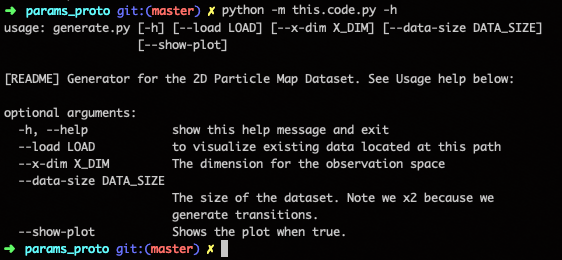params-proto, A Python Decorator That Gives Your Model Parameters Super-power
- 2022/07/04:
- Move
neo_prototo top-level, move olderparams_prototov1namespace. - Implement nested update via global prefix. No relative update via
**kwargs, yet - Fix
to_valuebug in Flag
- Move
- 2021/06/16: Proto now supports using environment variables as default.
- 2021/06/13: 5 month into my postdoc at MIT, add
sweep.save("sweep.jsonl")to dump the sweep into ajsonlfile for large scale experiments on AWS. - 2019/12/09: Just finished my DeepMind Internship. Now
params-protocontain a new proto implementation, and a complementary hyperparameter search library! Seeneo_protoandneo_hyper. - 2019/06/11: Now supports
tab-completionat the command line! - 2018/11/08: Now supports both python
3.52as well as3.6!‼️ ⭐
What is "Experiment Parameter Hell"?
"Experiemnt Parameter Hell" occurs when you have more than twenty parameters for your ML project that are all defined as string/function parameters with click or argparse. Sometimes these parameters are defined in a launch script and passes through five layers of function calls during an experiment.
Your Python IDEs work very hard on static code analysis to intelligently make you more productive, and the "parameter hell" breaks all of that.
Step 1: Declarative Pattern to the Rescue!
For this reason, you want to avoid using dictionaries or opaque argparse definitions as much as possible. Instead, you want to write those declaratively, so that your IDE can actually help you navigate through those layers of function calls. The hyper-parameter library, params_proto makes this easy, by integrating python namespaces (a bare python class) with argparse, so that on the python side you get auto-completion, and from the command line you can pass in changes.
Installation
First let's install params-proto and its supporting module waterbear
pip install params-proto waterbearThen to declare your hyperparameters, you can write the following in a your_project/soft_ac/config.py file:
import sys
from params_proto.proto import ParamsProto, Flag, Proto, PrefixProto
# this is the first config schema
class Args(PrefixProto):
"""Soft-actor Critic Implementation with SOTA Performance
"""
debug = True if "pydevd" in sys.modules else False
cuda = Flag("cuda tend to be slower.")
seed = 42
env_name = "FetchReach-v1"
n_workers = 1 if debug else 12
v_lr = 1e-3
pi_lr = 1e-3
n_initial_rollouts = 0 if debug else 100
n_test_rollouts = 15
demo_length = 20
clip_inputs = Flag()
normalize_inputs = Flag()
# this is the second schema
class LfGR(PrefixProto):
# reporting
use_lfgr = True
start = 0 if Args.debug else 10
store_interval = 10
visualization_interval = 10Step 2: Sweeping Hyper-parameters 🔥
Then you an sweep the hyperparameter via the following declarative pattern:
from rl import main, Args
from params_proto.hyper import Sweep
if __name__ == '__main__':
from lp_analysis import instr
with Sweep(Args, LfGR) as sweep:
# override the default
Args.pi_lr = 3e-3
Args.clip_inputs = True # this was a flag
# override the second config object
LfGR.visualization_interval = 40
# product between the zipped and the seed
with sweep.product:
# similar to python zip, unpacks a list of values.
with sweep.zip:
Args.env_name = ['FetchReach-v1', 'FetchPush-v1', 'FetchPickAndPlace-v1', 'FetchSlide-v1']
Args.n_epochs = [4, 12, 12, 20]
Args.n_workers = [5, 150, 200, 500]
# the seed is sweeped at last
Args.seed = [100, 200, 300, 400, 500, 600]
# You can save the sweep into a `jsonl` file
sweep.save('sweep.jsonl')
for i, deps in sweep.items():
thunk = instr(main, deps, _job_postfix=f"{Args.env_name}")
print(deps)and it should print out a list of dictionaries that looks like:
{Args.pi_lr: 3e-3, Args.clip_inputs: True, LfGR.visualization_interval: 40, Args.env_name: "FetchReach-v1", ... Args.seed: 100}
{Args.pi_lr: 3e-3, Args.clip_inputs: True, LfGR.visualization_interval: 40, Args.env_name: "FetchReach-v1", ... Args.seed: 200}
{Args.pi_lr: 3e-3, Args.clip_inputs: True, LfGR.visualization_interval: 40, Args.env_name: "FetchReach-v1", ... Args.seed: 300}
...Where Can I find Documentation?
Look at the specification file at ./test_params_proto/*.py , which is part of the integrated test. These scripts contains the most comprehensive set of usage patters!!
The new version has a neo_ prefix. We will deprecate the older (non-neo) version in a few month.
Writing documentation as uhm..., man page?
Params-Proto exposes your argument namespace's doc string as the usage note. For users of your code, there is no better help than the one that comes with the script itself!
With
params-proto, your help is only one-haway :)
And Your code becomes the documentation.
Tab-completion for your script!
params_proto uses argparse together with argcomplete, which enables command line autocomplete on tabs! To enable run
pip install params-proto
# then:
activate-global-python-argcompleteFor details, see argcomplete's documentation.
Why Use Params_Proto Instead of Click or Argparse?
Because this declarative, singleton pattern allows you to:
Place all of the arguments under a namespace that can be statically checked.
so that your IDE can:
- Find usage of each argument
- jump from anywhere in your code base to the declaration of that argument
- refactor your argument name in the entire code base automatically
Params_proto is the declarative way to write command line arguments, and is the way to go for ML projects.
How to override when calling from python
It is very easy to over-ride the parameters when you call your function: have most of your training code directly reference the parser namespace (your configuration namespace really), and just monkey patch the attribute.
params-proto works very well with the clound ML launch tool jaynes. Take a look at the automagic awesomeness of jaynes:)
To Develop And Contribute
git clone https://github.com/episodeyang/params_proto.git
cd params_proto
make devTo test, run the following under both python 3.52 and 3.6.
make testThis make dev command should build the wheel and install it in your current python environment. Take a look at the ./Makefile for details.
To publish, first update the version number, then do:
make publish

